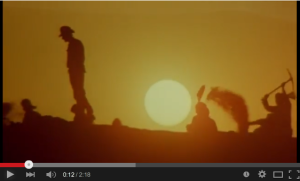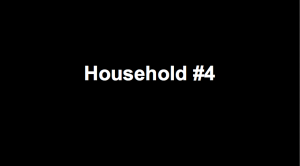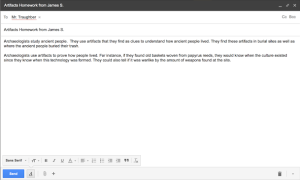Unit Objective
-
Using a geographical map of the world, the students will be able to identify and label the main centers of earliest human civilization with 90% accuracy.
-
Writing at least two paragraphs, the students will be able to explain how artifacts are discovered and used to understand ancient cultures without error.
-
At the end of the unit, the students will be able to compare civilizations and identify commonalities that aided in their establishment
Background and Rationale
The lesson is focused on understanding where we gain understanding of ancient cultures. This is an introductory lesson to World History and will appear early in the course. As a foundation, this lesson will aid students in understanding how archaeologists work and use artifacts to understand ancient cultures. Students will have been taught Google Slides basics in preparation for this lesson.
Lesson Objectives
Objective |
Bloom’s Verb |
|---|---|
|
Write out an explanation of the role of the archaeologist in understanding world cultures without factual errors. |
Understanding |
|
Demonstrate in writing how an archaeologist identifies artifacts and draws conclusions about them. |
Analyzing |
|
Compare civilizations and identify commonalities that aided in their establishment.
|
Analyzing |
|
Create a presentation showing their conclusions of who produced the collected trash and provide data that supports them. |
Creating |
Bloom’s Taxonomy
Creating (highest level)
Common Core / State and District Standards
-
Common Core Standard – CCSS.ELA-Literacy.W.9-10.1 Write arguments to support claims in an analysis of substantive topics or texts, using valid reasoning and relevant and sufficient evidence.
Learning and Innovation Skills (P21.org)
Creativity and innovation
-
Critical Thinking/Communication
Life and Career Skills (P21.org)
Initiative and Self Direction: Work Independently
-
Monitor, define, prioritize and complete tasks without direct oversight
Information, Media, and Technology Skills (P21.org)
- Students need to be able to:
-
operate computer
-
access online site – google.com/slides/
-
insert photos from computer/external drive
-
Lesson – Introduction
The instructor will discuss famous detectives and their role in uncovering clues to find answers. The instructor will explain that they are about to become become detectives in identifying different households from around the school.
Lesson Activities and Procedures
Student Procedure |
Teacher Procedure |
Materials |
|---|---|---|
| Students will take skeletal notes from the teacher’s discussion |
The teacher will introduce the concept of archaeology and what the job of the archaeologist entails. (10 minutes)
|
Computer for notetaking |
|
The students will work collaboratively to navigate through a bag of trash. |
The teacher will divide the classroom into groups of 3 to 4 people. (3-5 minutes) and have each group to open/catalogue items from bags of trash. (20 minutes)
|
8 bags of trash collected from neighborhood (filtered for content) |
|
Students will begin working individually on writing explanations for who are the owners of the trash while providing supporting evidence. (10-15 minutes or end of class) |
The teacher will provide manipulatives to match for the students who are not at the board. (10 min) | |
|
Students will be introduced to What Makes You Think That? thinking routine. (5 minutes) |
The teacher will share a thinking routine What Makes You Say That and will have the students to use it to justify their reasoning. |
|
| Students will fill in a form for the thinking routine giving explanations for how they identified Race/Ethnicity Gender Age Economic Background Interests/Activities Other (10 minutes) |
The teacher will guide the students as they fill out a form providing explanations for how they identifiedRace/Ethnicity Gender Age Economic Background Interests/Activities Other (10 minutes) |
Form for explanations |
|
The students will create a Google slide show to display their conclusions for the What Makes You Think That? routine. (10 minutes) |
The teacher will use a rubric to evaluate the students as they choose a speaker of the group to reveal artifacts + conclusions with a photo from google.com/images of the “type” of owner of the trash. (20 minutes) |
Google Slides |
Lesson Closure
Instructor will talk about how archaeology can be seen in books and also movies. The instructor will show movie trailer for Indiana Jones and the Raiders of the Lost Ark:
Assessment

Formative: Throughout the lesson, the instructor will quiz students on what they find in the examination of the trash and how archaeologists would use that information to understand ancient societies. Further, the instructor will challenge students during the What Makes You Think That? routine to gather information about the level of understanding held by the students.
Summative: In addition to the google slides presentation, students will send an email to the instructor containing at least two paragraphs explaining the role of the archaeologist, where they find artifacts, and how they use the artifacts to understand the society.
Structure (2 points):
1) Writes in complete sentences
2) Uses appropriate grammar
3) Uses appropriate punctuation
4) Wrote two complete paragraphs
Content (8 points):
1) Explains role of Archaeologist
2) Shows understanding of artifacts
3) Adequately explains how Archaeologists use artifacts
On Time (1 point):
1) Assignment submitted on time




